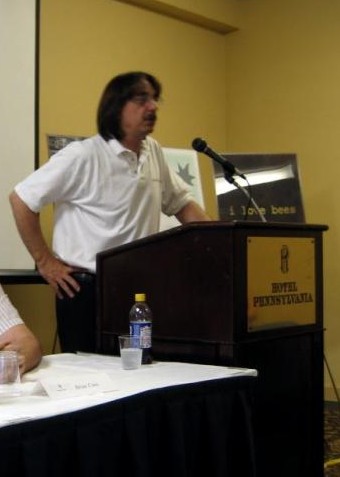Auch in diesem Jahr führen wir unsere Interviews bekannter Puppetmaster und Argonauten in der Kategorie 15 Fragen fort. Den Auftakt macht im frisch angebrochenen Jahr Dave Szulborski , der nicht nur im Bereich Alternate Reality Games bereits nicht mehr wegzudenken ist.
Aus seiner Feder sind bereits einige Bücher entsprungen, in denen er das Thema Alternate Reality Gaming einer breiten Öffentlichkeit auf charmante, informative und zugleich witzige Art und Weise nahe bringt. Das wohl bekannteste Buch von ihm ist „This Is Not A Game „, in dem er auch über die Anfänge der ARGs berichtet, genauso wie er über die Freuden und möglichen Leiden des Puppetmasterings erzählt.
„, in dem er auch über die Anfänge der ARGs berichtet, genauso wie er über die Freuden und möglichen Leiden des Puppetmasterings erzählt.
1) About when and how did you get in touch with ARGs?
I started playing ARGs with the EA game in 2001 Majestic, shortly after The Beast had concluded. I had heard about The Beast and saw some of the in-game content while the game was live but unfortunately never got seriously involved with it. I did however get very much into Majestic for which I was beta-tester. Despite its flaws I enjoyed the game immensely and saw so much potential in the genre that I began making my own games while Majestic was still running. In fact, my very first ARG was set inside the Majestic universe to some extent, and came about as a result of one of the major flaws in the game design – the excessive periods of “downtime.” EA built the game so players were only given an hour or less of game play each day, so I decided that the thousands of players sitting there for the other 23 hours of every day made a perfect “captive audience” for my first foray into ARG making. This game was technically the first ever grassroots ARG, since it was created and run successfully in 2001 while Majestic was still going on. My second game was also created and run during Majestic, under the auspices of the BIOS program, and became part of the official canon of the game when it was featured both on the main in-game website and EA monthly newsletter.
2) Did you take part in some ARGs as a player, too? Which?
I’ve been involved as a player at various levels in quite a few different ARGs, starting with Majestic and including Push: Nevada, MetaCortechs, and Last Call Poker, along with many of the smaller grassroots games. Sadly, my work schedule over the last couple of years hasn’t left a lot of time to be seriously involved in any games but I do try and stay up-to-date with almost all the games being discussed at the UnFiction forums.
3) In which ARGs have you been Puppetmaster/BHTS and what was your job in those?
2001 – 2 games as a solo Puppetmaster:
- ChangeAgents
- ChangeAgents: Operation Mindset – done as part of the Majestic BIOS program and featured on the EA game website and newsletter]
2002 – 1 game as a solo Puppetmaster:
- ChangeAgents: Out of Control
2003 – 1 game as creator / lead Puppetmaster with grassroots PM team:
2004 – 1 game as creator / lead Puppetmaster with grassroots PM team:
2005 – 1 game as creator / lead Puppetmaster with grassroots PM team:
1 game as Puzzle designer on commercial ARG:
2006 – 1 game as creator / lead Puppetmaster with grassroots PM team:
1 game as Puzzle designer on commercial ARG:
2 ARG-ish commercial online campaigns
- Dreamworks and HP’s HedgeGames with Campfire – designed 100 themed puzzles to promote Dreamworks’ animated film Over the Hedge
- Travelocity Gnomewatch campaign with McKinney-Silver – online interactivity consultant
4) Which ARG do you like best and why?
That’s a really difficult question to answer, because there are certain elements of all the various ARG campaigns I have been involved with that are very special to me, making it extremely hard to single out one particular game as a favorite. Overall, if I was forced to make a choice, I’d probably pick the Art of the Heist, primarily because it had the budget to try and successfully pull off things no other ARG has ever done before. The game was wonderfully written and produced and blurred the lines of reality and fiction very effectively, making it a truly powerful and immersive experience for thousands of players. Plus, some of the puzzles I made for the campaign, including the infamous Evil Cube, were very unique and well-done, if I don’t sound too immodest saying so myself.
5) Which was the funniest/nicest happening while doing/playing an ARG?
The nicest thing that has ever happened is probably the flood of overwhelming “Thank You” messages I received at the end of Chasing The Wish. So many people wrote to me and told me how much they enjoyed and learned from the game, some of them even claiming that it literally changed their lives. This tremendous response made all the hard work worthwhile while also reaffirming in my mind how special this genre and the community that has grown up around it truly are.
The funniest thing will be explained in the following answer.
6) Are there any memories to happenings that you wanted to forget about?
The funniest thing that ever happened to me in one of my ARGs is also something that I’d love to forget about but probably never will. It has to do with an actual book of poetry we created and published for the Urban Hunt ARG called Dead Poems. The book consisted of dozens of pages of original poems and artwork, many of which had secret messages hidden or encrypted within. Because so many poems and puzzles were needed for the book, I asked the other PM team members to come up with puzzle ideas that we could use, with plans of inserting the actual specific story information in the form of clues and solutions later. One of the PMs came up with a great format for a puzzle with the words “Insert puzzle here” used as the solution for the sample she provided me. The entire team loved the puzzle concept and I filed it away for modification later when we actually got around to making the Dead Poems book.
Can you guess what happened next?
I forgot to change the sample puzzle in the rush to get the book done and left the temporary solution in for players to find. Needless to say they did, so amongst a batch of clever and heavily story-related puzzle poems, they found a certain entry that, when solved, yielded the “Insert puzzle here” answer. Despite how painfully stupid and embarrassing it was, I couldn’t help but laugh about it for days and still do when I tell the story.
7) How do you explain ARGs to your family / friends / relatives and how do they react?
I’ve been doing this for over six years now so almost everyone in my family or immediate circle of friends already knows about ARGs and what I do. For people who don’t, however, I most often use the analogy of an interactive novel, that uses the Internet and its various technologies and communication methods – email, IMs, video, audio, etc. – to present itself as real and allow you to participate in and often even influence it. I find most people have the easiest time understanding the concept if you begin with the idea that it is basically just a story, told in some new and wonderful ways via the power of computers and the Internet.
8) Which 3 things does an ARG really need to have, to be a good ARG in your opinion?
First and foremost is obviously a good story. Since ARGs are essentially storytelling, they can’t be good without a unique and engaging story to start from. But for ARGs it’s important to realize that story means more than just plot and the events of the tale you are telling. It also means the mechanics of how the plot and happenings are delivered to the audience. In all other forms of media and storytelling, there is one primary form of delivering the narrative. ARGs are truly multimedia experiences however, combining elements from many of the various traditional storytelling formats – video, text, fictional artifacts, real time conversations and interactions, and so on. So for all intents and purposes, a good story in an ARG means both a well-written and cleverly delivered narrative.
Second, ARGs to be truly engaging and immersive need to allow the audience to interact with the fictional world of the game in meaningful ways. This doesn’t mean just sending email and receiving canned auto-replies. On the simplest level, a good ARG would have personalized email responses, hopefully serving an integral role in the game. But interaction needs to go far beyond that and exist on several levels in a well done ARG campaign. One very important form of interaction overlooked in many games is what’s often called the “archeology” of the narrative, meaning the players need to find pieces of the segmented and disassociated narrative and reassemble it into a meaningful tale. This can be done in many ways; from having the audience discover new websites and characters through their efforts to giving them actual story fragments as the reward for solving puzzles and similar in-game actions. The one critical factor to all the forms of interaction you can build into your ARG is to make sure that the individual player interactions actually affect their experience of the campaign, and that the collective interactions of the audience impact the unfolding of the narrative in some meaningful and rewarding way.
Finally, the third element a good ARG needs to have is consistency, again having multiple meanings and implications when it comes to this genre. Most obviously it means that the fictional world of the game needs to be internally consistent; whether it is set in the future, the present, or the past, the game space and play the ARG provides should be consistent throughout the campaign, according to the rules you’ve established for the fictional world. Consistency also implies a steady level of quality and action throughout the campaign, and sometimes even a semi-regular schedule for updates and interactions within the game. Each of these things can go a long way in helping make an ARG a “good” game.
9) Do you have a favourite character from an ARG?
Hmm, that’s an unfair question. If I based my answer purely on the fictional characters as they were presented in various ARGs, meaning as the writers wrote them, basically, I’d have a very different answer than the one I’m about to give. But, after sitting next to and talking with her for about an hour while we waited for the Park Avenue Art of the Heist live event to begin, there’s just no way I can say anything but Nisha, Nisha, Nisha.
10) What are you currently working on? (if you may tell us/are allowed to tell us 😉 )
I would absolutely love to tell you but as your question anticipated, I really can’t. At least as far as commercial ARGs and similar projects go. There are a few other things I’m involved in or working on I can mention though, including writing a couple of pieces about specific ARG campaigns for an upcoming book called Space. Time. Play. Games, Architecture, and Urban Planning. I’m also speaking at Florida University’s Games and Digital Media Conference on March 1st and 2nd, and hoping to attend the ARGFest and GDC immediately afterward.
I can also vaguely mention without spilling too many beans that I am working with major production companies on both movie and TV projects designed to bring ARG-like experiences to those media. More on that very soon, I promise.
11) Which puzzle from past ARGs do you like best/was real fun? Can you tell us why?
Well, I’ve already mentioned the Evil Cube from the Art of the Heist. That was a truly fun and challenging puzzle. It was a word search puzzle basically, with a 20 x 20 letter grid. Oh yeah, it was also three dimensional, extending 20 layers along the z axis too, along with the traditional x and y axes found in common word search puzzles. The puzzle had words hidden on every single level and in every way possible, on single planes and going back depth wise into the puzzle as well. Finally, every single letter on the 20 levels of grids was meaningful and was part of an encryption in some way. I found a way to take what is normally considered “filler text” in these puzzles and made all of it part of smaller puzzles and clues.
For pure fun though, I’d have to pick the original Turing Principle chatbots from Chasing The Wish. Turing Principle was an actual programmed AIM chatbots that interacted in real time conversation with the players. Its programming was literally crammed full of small puzzle trails though, so saying certain keywords would open whole new areas of conversation and knowledge for the players. Occasionally, I would jump online and supplement the chatbot’s programmed answers, which it very hard to tell if it was a real person or a bot at times.
12) Do you have something like a „phrase“/“objective“ which you follow while organizing and running an ARG?
I don’t have any strict formula or even procedure for creating and running an ARG. Each one is such an individual project that they really require customized plans and methods for much of the games. There are some simple and basic rules, such as having an adequately sized and skilled team, etc., but you can read those in many other places so I won’t repeat them here.
13) Do you remember a situation, in which you wanted to give up anything? What happened?
No, I’ve never really wanted to give up although there have been many, many times that running an ARG became so overwhelming it was certainly tempting. Most often I’ve found these situations result from my own mistakes or poor planning, as I find myself unable to keep up with creating and running the campaign at the same time. Perhaps most discouraging though is to actually struggle through a period like that, where you are literally not sleeping for days on end and giving everything you have to the game, only to have a player post a totally scathing and negative comment about the game or some specific event in it to one of the community forums. You definitely have to be thick-skinned to be able to handle the criticism bound to come with any ARG campaign (I can’t think of one that wasn’t soundly criticized for something by the players at one point or another) but sometimes it’s very, very hard to get past.
14) Was there something like a favourite item from an ARG that you didn’t want to give away, but you had to, because the IG-Character had to?
Another difficult question because there have been so many special items included in my games. At the top of the list would have to be the various hand made calligraphy pages from Chasing The Wish and the various masks from the sequel, Catching The Wish.
15) How do you see the future of ARGs?
I certainly no prophet and am usually too busy with current projects to look too far ahead into the future for the genre. I would say that ARGs as a whole are really still finding and filling a level of defining themselves, so any ARG that tries and successfully incorporates new technologies, narrative forms and techniques, audience immersion and involvement methods, and so on, could legitimately be seen as the “next step” or future of ARGs. But I see it not so much a step upward as a step outward, as ARGs are just beginning to fill the huge potential that the genre affords.
Are there ways to make ARGs even more realistic and immersive? Certainly. You’ll see many of them in upcoming projects, so I can’t necessarily provide details and examples at this point. In general though, many of them have to do with using a broader canvas to tell the story, using the incredibly diverse multimedia platform that the age of pervasive broadband Internet affords us as creators.
I also think we’ll see a push to make more ARGs as stand alone entertainment vehicles and not necessarily tied to marketing campaigns. Important people are finally starting to realize the power of this new genre of storytelling and treat it as the potentially revolutionary art form it truly is.
Thank you very much for taking the time to answer our 15 questions, Dave (PM) 🙂
Vielen Dank, Dave, daß du dir die Zeit für die Beantwortung unserer 15 Fragen genommen hast.
 Einer der kreativen Köpfe von 42 Entertainment ist Sean Stewart.
Einer der kreativen Köpfe von 42 Entertainment ist Sean Stewart. (E) veröffentlicht, das nicht nur für unsere weiblichen Leser interessant sein dürfte. Genauso ist zum Beispiel auch der schwarze Dolch
seiner Feder entsprungen.






